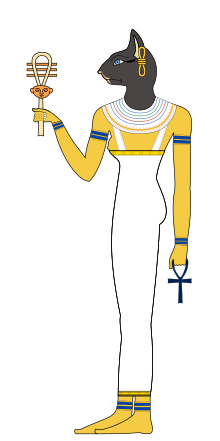
Back Bastet Afrikaans Bastet ALS باستت Arabic باستيت ARZ বাষ্টেট Assamese Bastet Azerbaijani Баст Byelorussian Баст BE-X-OLD Бастет Bulgarian Bastet Breton
| Bastet | ||||
|---|---|---|---|---|
 | ||||
| Name in hieroglyphs |
| |||
| Major cult center | Bubastis | |||
| Symbol | lioness, cat, ointment jar, sistrum, solar disk | |||
| Genealogy | ||||
| Parents | Ra and Isis | |||
| Siblings | Horus and Anhur (half-brothers) | |||
| Consort | Ptah (in some myths) | |||
| Offspring | Maahes | |||
Bastet (Ancient Egyptian: bꜣstt), also known as Ubasti,[a] or Bubastis,[b] is a goddess of ancient Egyptian religion possibly of Nubian origin, worshipped as early as the Second Dynasty (2890 BC). In ancient Greek religion, she was known as Ailurus (Koinē Greek: αἴλουρος, lit. 'cat').
Bastet was worshipped in Bubastis in Lower Egypt, originally as a lioness goddess, a role shared by other deities such as Sekhmet. Eventually Bastet and Sekhmet were characterized as two aspects of the same goddess, with Sekhmet representing the powerful warrior and protector aspect, and Bastet, who increasingly was depicted as a cat, representing a gentler aspect.[4]
- ^ Hart, George (2005). The Routledge Dictionary of Egyptian Gods and Goddesses, Second Edition, p. 45
- ^ "Coptic Dictionary Online". corpling.uis.georgetown.edu.
- ^ Badawi, Cherine. Footprint Egypt. Footprint Travel Guides, 2004.
- ^ Serpell, "Domestication and History of the Cat", p. 184.
Cite error: There are <ref group=lower-alpha> tags or {{efn}} templates on this page, but the references will not show without a {{reflist|group=lower-alpha}} template or {{notelist}} template (see the help page).
© MMXXIII Rich X Search. We shall prevail. All rights reserved. Rich X Search